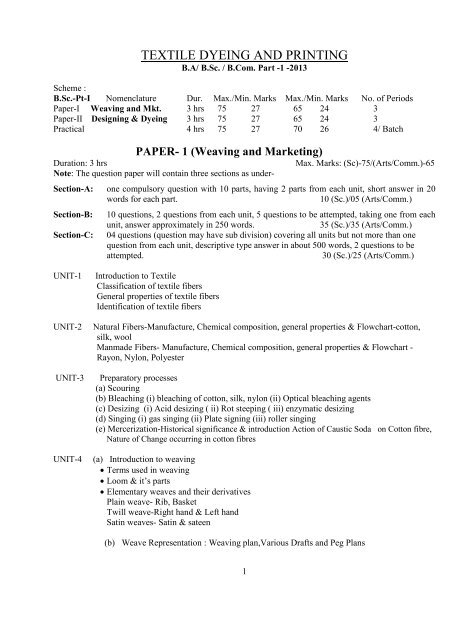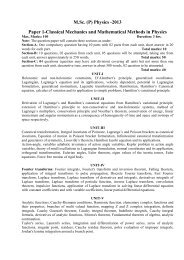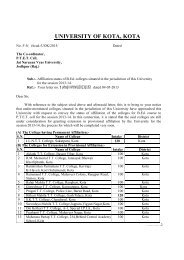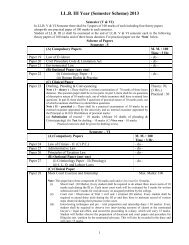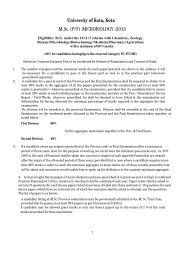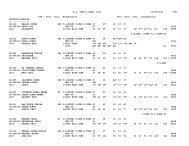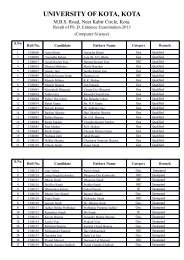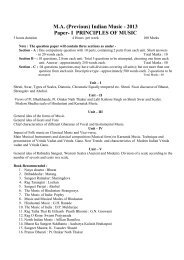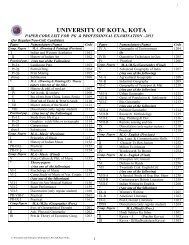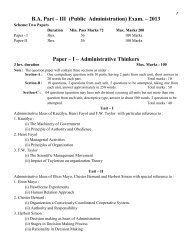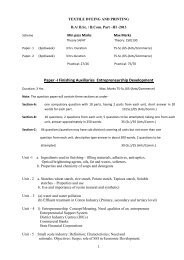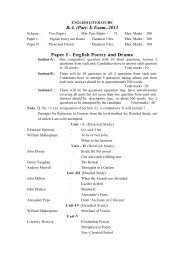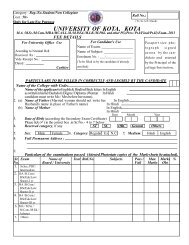TEXTILE DYEING AND PRINTING
TEXTILE DYEING AND PRINTING
TEXTILE DYEING AND PRINTING
- No tags were found...
Create successful ePaper yourself
Turn your PDF publications into a flip-book with our unique Google optimized e-Paper software.
<strong>TEXTILE</strong> <strong>DYEING</strong> <strong>AND</strong> <strong>PRINTING</strong>B.A/ B.Sc. / B.Com. Part -1 -2013Scheme :B.Sc.-Pt-I Nomenclature Dur. Max./Min. Marks Max./Min. Marks No. of PeriodsPaper-I Weaving and Mkt. 3 hrs 75 27 65 24 3Paper-II Designing & Dyeing 3 hrs 75 27 65 24 3Practical 4 hrs 75 27 70 26 4/ BatchPAPER- 1 (Weaving and Marketing)Duration: 3 hrsNote: The question paper will contain three sections as under-Max. Marks: (Sc)-75/(Arts/Comm.)-65Section-A: one compulsory question with 10 parts, having 2 parts from each unit, short answer in 20words for each part.10 (Sc.)/05 (Arts/Comm.)Section-B:Section-C:10 questions, 2 questions from each unit, 5 questions to be attempted, taking one from eachunit, answer approximately in 250 words.35 (Sc.)/35 (Arts/Comm.)04 questions (question may have sub division) covering all units but not more than onequestion from each unit, descriptive type answer in about 500 words, 2 questions to beattempted.30 (Sc.)/25 (Arts/Comm.)UNIT-1UNIT-2UNIT-3UNIT-4Introduction to TextileClassification of textile fibersGeneral properties of textile fibersIdentification of textile fibersNatural Fibers-Manufacture, Chemical composition, general properties & Flowchart-cotton,silk, woolManmade Fibers- Manufacture, Chemical composition, general properties & Flowchart -Rayon, Nylon, PolyesterPreparatory processes(a) Scouring(b) Bleaching (i) bleaching of cotton, silk, nylon (ii) Optical bleaching agents(c) Desizing (i) Acid desizing ( ii) Rot steeping ( iii) enzymatic desizing(d) Singing (i) gas singing (ii) Plate signing (iii) roller singing(e) Mercerization-Historical significance & introduction Action of Caustic Soda on Cotton fibre,Nature of Change occurring in cotton fibres(a) Introduction to weaving• Terms used in weaving• Loom & it’s parts• Elementary weaves and their derivativesPlain weave- Rib, BasketTwill weave-Right hand & Left handSatin weaves- Satin & sateen(b) Weave Representation : Weaving plan,Various Drafts and Peg Plans1
UNIT-5Meaning, nature& scope of marketing• Role & importance of marketing in modern economy.• Meaning and importance of marketing mix• Products, Pricing, Physical distribution ,PromotionReferences1. Textiles- Bucker-(1998)Abhishek Publication2. .Essentials of Textiles- M.Joseph, Holf Rinechants,3. Textile -Year 1998-By A.F. Barker -Chapter 7, Principles of weaving-Pg.154-1744. Weaving Technology-M.M.Kulkarni, Virinda Publication, Jalgon5. Principles and practice of Dyeing- V A Shenai, 1993 Sevak Publications.B.A/ B.Sc. / B.Com. Part -1Paper-II (Designing & Dyeing)Duration: 3 hrsNote: The question paper will contain three sections as under-Max. Marks: (Sc)-75/(Arts/Comm.)-65Section-A: one compulsory question with 10 parts, having 2 parts from each unit, short answer in 20words for each part.10 (Sc.)/05 (Arts/Comm.)Section-B:Section-C:10 questions, 2 questions from each unit, 5 questions to be attempted, taking one from eachunit, answer approximately in 250 words.35 (Sc.)/35 (Arts/Comm.)04 questions (question may have sub division) covering all units but not more than onequestion from each unit, descriptive type answer in about 500 words, 2 questions to beattempted.30 (Sc.)/25 (Arts/Comm.)UNIT-1 1.Elements of design (line, form, colour, texture, tone, space)2. Principle of design (unity, harmony, balance, dominance, rhythm, proportion)3. Definition of Motifs & its characteristics with reference-Classification of motifs (i) Traditional (ii) Modern-Types of motifs (i) Geometrical (ii) Stylized (iii) figurative (iv) Abstract(v) Folk (vi) Tribal4. Concept of Repeat in Design:Types of Repeats: Plain, Vertical, Horizontal, Twill, Mirror, Half step, All over.Unit 2Unit 3Nomenclature of Dyes: Colour and Dyes, colouring and Dyeing.The dye molecule (chromophores and auxochromes)Theory of dyeing (Affinity of a dye, role of water, electrolytes, heat)Dye auxiliary: Carriers or swelling agents, leveling agents (anionic leveling agents and cationicleveling agents).Classification of dye-stuff and its properties(A) Natural - (a) Vegetable (b) Animal (c) Mineral(B)Synthetic dyes - Acid dyes, direct dyes, reactive dyes,Vat dyes, Sulphur dyes, Azoic dyes2
Unit 4Dyeing of textile goods in various forms and machinery employed(A) Dyeing of loose fibers(B) Dyeing of yarni.Hank dyeing machineii.Cheese/Bobbin dyeing machineiii.Beam dyeing machine(C) Cloth dyeingi.Jigger dyeing machineii.Winch dyeing machineiii.Padding mangleiv.Thermosole processv.Dope dyeingUnit 5 Study of dyed textiles according to colour, dyes, motifs & techniques:a) Patola b) Ikat c) Pochampalli d) BandhaniReferences:Bosom worth Dorothy (1995): The encyclopedia of patterns and motifs, Studio editions, LondonGrociki, Z.J.; Watsons Textile Design and Colour, London, Newness Butter WorthV.A.Shenai (1987),Chemistry of dyes and principles of Dyeing, Sevak Prakashan, MumbaiV.A.Shenai (1987) Technology of Textile Processing, Vol.IV, Sevak Publication.'kfeZyk xqtZj ß oL= dh jaxkbZ ,oa NikbZÞTechnology of Textile Processing -Vo.II, Chemistry of Dyes and Principles of Dyeing, V.A. Shenai, 1993,Sevak Publications.PracticalMax. marks 75 for science Min. marks 27 for scienceMax. marks 70 for arts Min. marks 26 for arts(Four pd/week)Duration Four-Hrs.1. Colour wheel, primary, secondary, tertiary colour, cool colours, warm colours Monochromatic,complimentary polychromatic, analogous colour2. Tie and Dye (Different patterns on handkerchiefs) with direct dyes.3. Assan- weaving (10″x10″)4. Identification of fibers – cotton, silk, wool, polyester, nylon.4. Assessing ends and picks per inch of different fabrics6. Preparation of fabrics for dyeing & printing (desizing, scouring, bleaching)7. Dyeing with Direct, Acid and Sulpher dyes in different shades8. Field and industrial visit3


